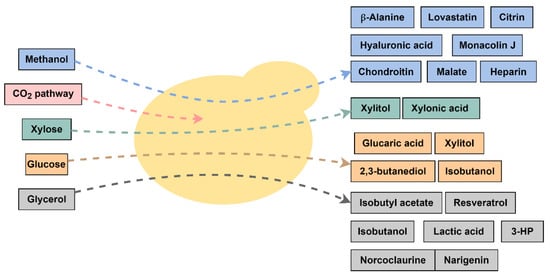The need for a more sustainable society has prompted the development of bio-based processes to produce fuels, chemicals, and materials in substitution for fossil-based ones. In this context, microorganisms have been employed to convert renewable carbon sources into various products. The methylotrophic yeast Komagataella phaffii has been extensively used in the production of heterologous proteins. The Mobligate aerobic yeastre recently, Komagataella phaffii ist a non-pathogenic certified and generally recognizehas been explored as a safe (GRAS) microhost organism. It is classified in the Saccharomycetales order and Saccharomycetaceae family to produce various chemicals through new metabolic engineering and synthetic biology tools.
- Komagataella phaffii
- Pichia pastoris
- strain engineering
- metabolic engineering
1. Introduction

2. Komagataella Taxonomy and Diversity
The obligate aerobic yeast Komagataella phaffii is a non-pathogenic certified and generally recognized as a safe (GRAS) microorganism. It is classified in the Saccharomycetales order and Saccharomycetaceae family. For being capable of using methanol as the only carbon source, K. phaffii is methylotrophic and was anteriorly known as Pichia pastoris. Phylogenetic studies placed P. pastoris in the genus Komagataella proposed by Yamada et al. (1995) after the analysis of partial sequences of rRNAs subunits (18S and 26S) of the 12 strains of methanol assimilating yeasts [14][16]. Supporting this previous study, Kurtzman and Robnett (1998) compared gene sequences (D1/D2 LSU rRNA) of about 500 species of Ascomycetous yeasts. The multigenic sequence analysis sustained the phylogenetic position of Pichia pastoris in the Komagataella genus [15][17]. The first species of P. pastoris (described initially as Zygosaccharomyces pastoris) isolated from a chestnut tree was described in 1919 by Guilliermond [16][18]. Komagataella genus is currently composed of seven species, with most of them (including K. phaffii) isolated from tree exudates in North America and Europe (Table 1) [17][19]. All species have spherical to ovoid shapes white/cream colonies, and during asexual reproduction, haploid cells multiply via multilateral budding and do not have pseudohyphae or true hyphae. In sexual reproduction (diploid cells), the ascospore is hat-shaped, ranging from 1 to 4 spores (that can be conjugated or not) [18][20]. The Komagataella species can grow at high cell densities using methanol, glucose, or glycerol as a carbon source with a doubling time of 2 to 3 h, and ammonium can be used as a nitrogen source during growth [17][18][19,20]. Recently, it was demonstrated that some species from Komagataella, including K. phaffii, possess the capacity to grow on xylose [19][21].| Type Species | Strain | Genome Size (Mb) | Isolation | Origin | Carbon Sources | Ref |
|---|---|---|---|---|---|---|
| K. pastoris | CBS 704 | 9.6 | Aesculus species | France | Glucose Glycerol Methanol Ethanol Xylose |
ASM170810v1 A |
| K. phaffii | CBS 7435 | 9.4 | Quercus velutina | California, USA | ASM170808v1 A | |
| K. ulmi | CBS 12361 | 9.6 | Ulmus americana | Illinois, USA | [19][21] | |
| K. kurtzmanii | CBS 12817 | 9.6 | Fir flux | Arizona, USA | ||
| K. mondaviorum | CBS 15017 | 9.5 | Populus deltoides | California, USA | ||
| K. pseudopastoris | CBS 9187 | 10.6 | Salix alba | Hungary | ||
| K. populi | CBS 12362 | 9.3 | Populus deltoides | Illinois, USA |
